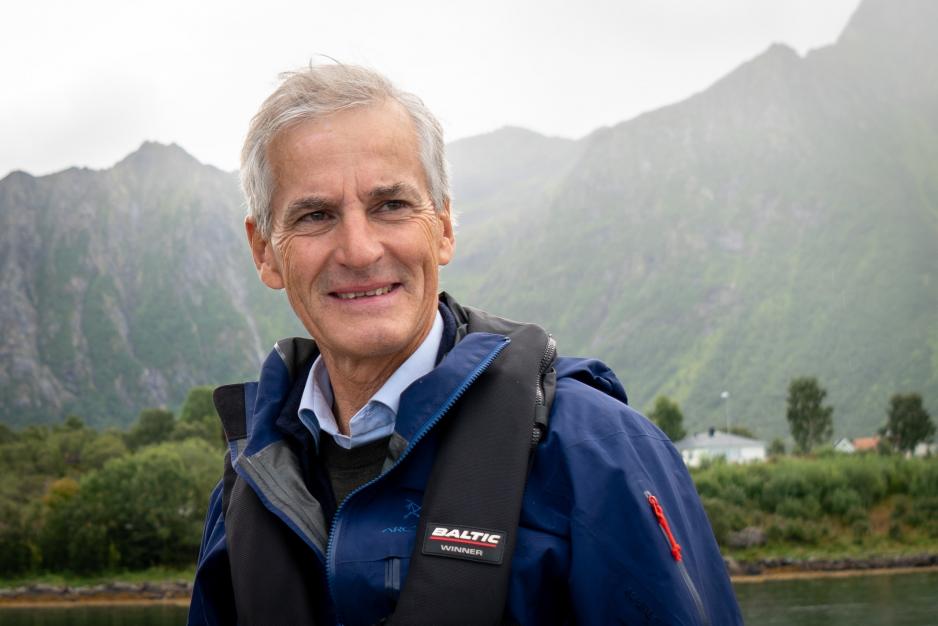New Norwegian High North Whitepaper: Labor Party Leader Jonas Gahr Støre: “Half-Hearted High North Policy”

“A state like Norway should require more from those who develop and refine our natural resources and make sure there are local ripple effects”, says Norwegian Labor Party Leader Jonas Gahr Støre. (Photo: The Labor Party)
Labor Party leader Støre argues that there is a big gap between words and actions in the new High North whitepaper that was launched last Friday. “This government has neither prioritized High North policies, developed new policies nor taken new initiatives in its meeting with the region’s opportunities and challenges”, says the Labor Party leader.
Last Friday, the Norwegian government presented its new High North whitepaper. The whitepaper is titled “People, opportunities and Norwegian interests in the High North”.
According to the whitepaper, the government’s overall goal for its High North policy is peace, stability and predictability, international cooperation and rule of law, overall and eco-system based governance, increased job and wealth creation, closer collaboration between business and knowledge institutions, as well as welfare and attractivity of living.
Jonas Gahr Støre, Labor Party leader, argues that the whitepaper is missing important initiatives that could boost Northern Norway.
“This is a whitepaper leaving a clear perspective on the gap between words and actions. In sum, we have a half-hearted High North policy. We have seen this before, in 2004. Towards the end of the then-Bondevik coalition government’s term in office, a High North policy was introduced after long-time demands from the Labor Party, the region and many in parliament. That whitepaper was descriptive and barely contained any initiatives”, Støre says and continues:
“It was only in 2005 that the then-Labor government made High North policies be about initiatives, projects and goals, with concrete plans to reach these. In 2013, a whitepaper was presented shortly after the new government was formed, establishing the priorities of the Labor-led coalition government. Now, an extensive new High North policy is launched only nine months prior to the next parliamentary elections.”
Støre adds:
“This government has not prioritized High North policies, developed new politics nor new initiatives in the face of the opportunities and challenges of the region when it comes to Russia and our Arctic neighbors, Norway has lost some of the power we had in leading and setting the agenda for cooperation in the Arctic. Norway has become vulnerable, if we are not at the forefront of initiatives and policies.”
Norway has lost some of the power we had in leading and setting the agenda for cooperation in the Arctic
North Norwegian capital fund
In the whitepaper, the government states that it will announce a mandate to govern a fund built on state and private means. The purpose of the fund will be to improve access to capital and the emergence of good governance communities in the High North. The fund is to be located in Northern Norway and targeting the parts of the market in which there is a stronger demand for capital than what is currently available from capital markets.
What are your thoughts on the North Norwegian capital fund that the government wants to establish?
“That fund is in part an expression of some of the problem. That fund was discussed and planned to be created in 2017 yet has not yet materialized. The fund has been scheduled for a long time already, but the government has not managed to establish it. The government’s stressing it is good, however, this is just a recycling of old policies. The new whitepaper is void of any new initiatives that could boost Northern Norway.”
Solid analyses
Is there anything you would agree to in the whitepaper?
“The whitepaper contains solid analyses, and I would argue that that is important. It is important that the policies discussed are built on solid analyses. The analyses take seriously the fact that people live their lives on land. The ocean areas are a defining opportunity for Norway; however, we live our lives on the land. Making sure that we in the north have competence, investments and ambitions about ripple effects is crucial”, he says.
Ripple effects in Northern Norway
Støre argues that we must talk more about ripple effects. He believes that if the local population does not see any ripple effects, that will create antipathy towards some industries.
“A state like Norway should require more of those who develop and refine our natural resources and make sure ripple effects are created and noticed locally. That is how it was with the oil and gas industry on the west coast from the early days, but that is not much the case in Northern Norway today. This is worrying”, he says and adds:
“There is no plan here for turning centralization around. On the contrary, the most important signal from the government to the municipalities is that the merging of municipalities is to continue. We warrant clear ripple effect requirements from industrial activity in the High North.”
Should we talk about Northern Norway rather than the High North?
“I believe it is important to talk about the High North, because if you only speak about Northern Norway, you will draw a line on the map saying that north of this line is the High North, and south of it are the southern areas. I believe it is very important for everything we have and develop in the north to also make use of competences found in Grimstad on the southern coast, the inland Raufoss industry park, the legal and economic communities in Bergen on the west coast, the technological communities in Trondheim, Central Norway”, Støre says. He adds:
“The Labor Party’s High North initiative never drew a line on the map. It has been about Northern Norway, Northern Europe, the North of the entire globe. And we want to put all our energy into that.”
You can read the whitepaper here [Norwegian only].
This article was originally published in Norwegian and has been translated by HNN's Elisabeth Bergquist.

